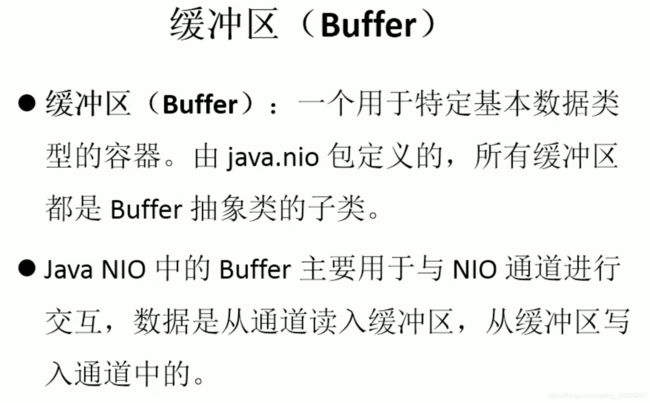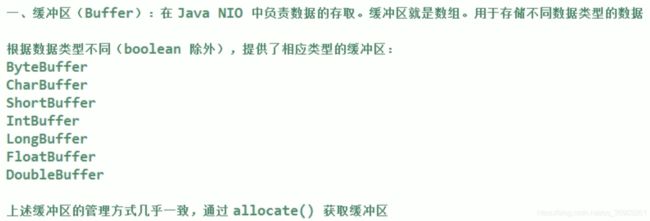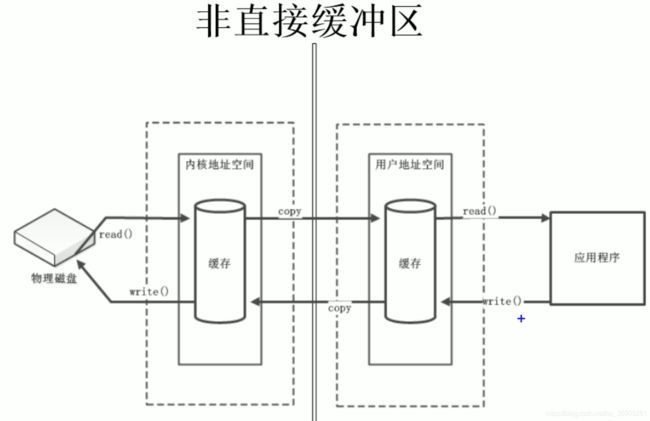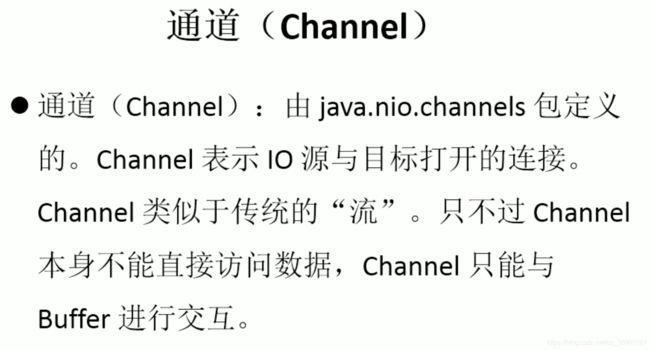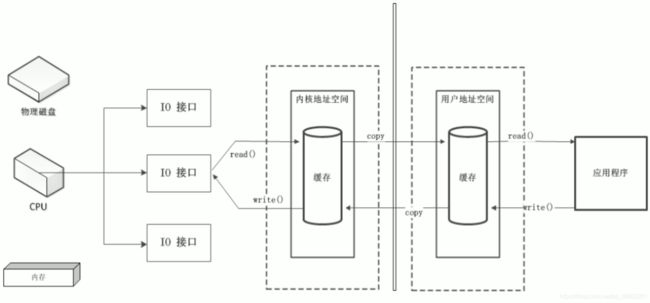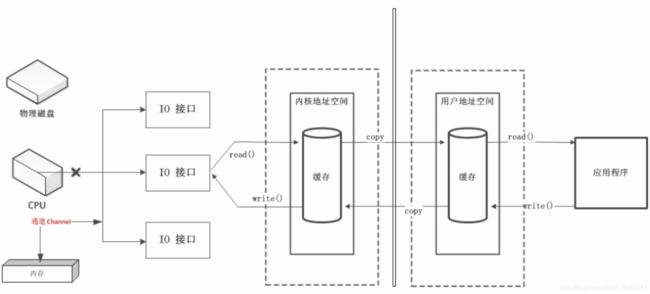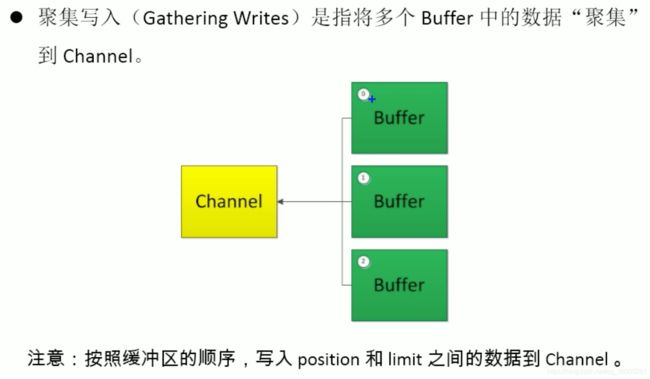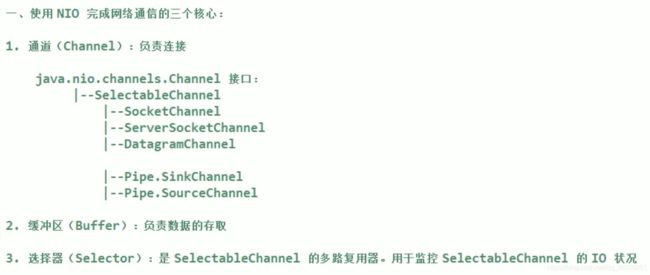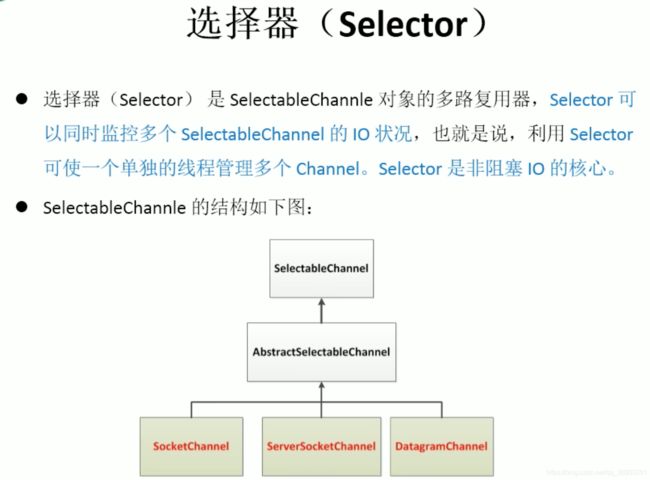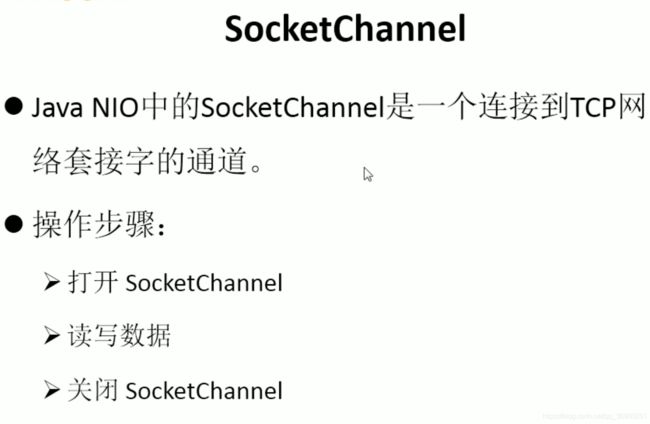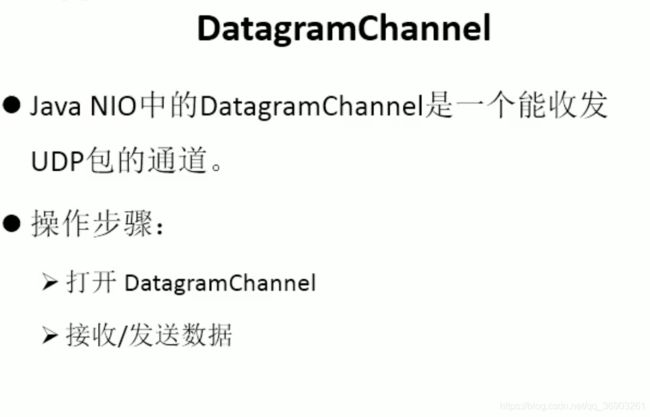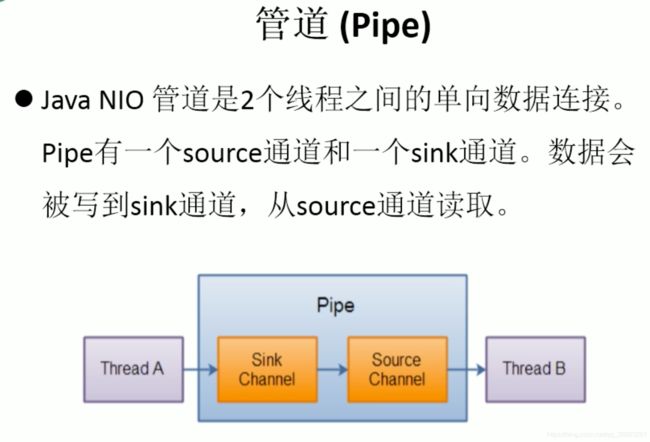NIO学习笔记
文章目录
- 一、通道(Channel)与缓冲区(Buffer)
- 缓冲区(Buffer)
- 直接缓冲区和非直接缓冲区
- 通道(Channel)
- 利用通道完成文件复制(非直接缓冲区)
- 使用直接缓冲区完成文件的复制(内存映射文件)
- 通道之间的数据传输
- 分散(Scatter)与聚集(Gather)
- 字符集(Charset)
- 二、NIO的非阻塞式网络通信
- 阻塞式IO实现网络通信
- 非阻塞式IO实现网络通信
- DatagramChannel
- 三、管道



一、通道(Channel)与缓冲区(Buffer)
缓冲区(Buffer)
- capacity:缓冲区的大小。
- limit:规定可操作的大小,在写数据模式下,和capacity相同,在读数据模式下,变为和写数据模式下的position相同。
- position:类似数组的index,在写数据模式下,指向当前空闲的位置,当position等于limit代表缓冲区可操作的空间已满,在读数据模式下,变为0,当position等于limit代表已读完全部数据。
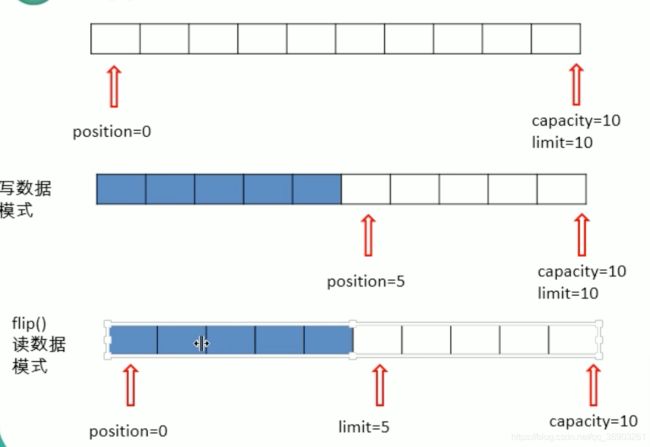
public class TestBuffer {
public static void main(String[] args) {
String str = "abcde";
//1. ByteBuffer.allocate(int):分配一个指定大小的缓冲区
ByteBuffer buf = ByteBuffer.allocate(10);
System.out.println("----------allocate()----------");
System.out.println("缓冲区总大小capacity:" + buf.capacity());
System.out.println("limit的位置:" + buf.limit());
System.out.println("position目前的位置:" + buf.position());
//2.put():存数据
buf.put(str.getBytes());
System.out.println("----------put()----------");
System.out.println("缓冲区总大小capacity:" + buf.capacity());
System.out.println("limit的位置:" + buf.limit());
System.out.println("position目前的位置:" + buf.position());
//3.flip():切换成读数据模式
buf.flip();
System.out.println("----------flip()----------");
System.out.println("缓冲区总大小capacity:" + buf.capacity());
System.out.println("limit的位置:" + buf.limit());
System.out.println("position目前的位置:" + buf.position());
//4.get():读数据
byte[] dst = new byte[buf.limit()];
buf.get(dst);
System.out.println("----------get()----------");
System.out.println(new String(dst));
System.out.println("缓冲区总大小capacity:" + buf.capacity());
System.out.println("limit的位置:" + buf.limit());
System.out.println("position目前的位置:" + buf.position());
//5.rewind():把position变为0,从头开始再读数据
buf.rewind();
System.out.println("----------rewind()----------");
System.out.println("缓冲区总大小capacity:" + buf.capacity());
System.out.println("limit的位置:" + buf.limit());
System.out.println("position目前的位置:" + buf.position());
//6.clear():清空缓冲区,limit和position初始化,但缓冲区的数据还在,只是处于"被遗忘"状态,可以被读取到
buf.clear();
System.out.println("----------clear()----------");
System.out.println("缓冲区总大小capacity:" + buf.capacity());
System.out.println("limit的位置:" + buf.limit());
System.out.println("position目前的位置:" + buf.position());
//因为clear()会影响mark标记,所以放到另一个方法
show();
}
public static void show(){
String str = "abcde";
ByteBuffer buf = ByteBuffer.allocate(10);
buf.put(str.getBytes());
buf.flip();
System.out.println("缓冲区总大小capacity:" + buf.capacity());
System.out.println("limit的位置:" + buf.limit());
System.out.println("position目前的位置:" + buf.position());
//从0开始,读两位
byte[] bs = new byte[2];
buf.get(bs);
System.out.println("第一次读取:");
System.out.println(new String(bs));
System.out.println("缓冲区总大小capacity:" + buf.capacity());
System.out.println("limit的位置:" + buf.limit());
System.out.println("position目前的位置:" + buf.position());
//7.mark:标记,记录position当前的位置
buf.mark();
System.out.println("----------mark()标记----------");
//从2开始,读两位
buf.get(bs);
System.out.println(new String(bs));
System.out.println("第二次读取:");
System.out.println("缓冲区总大小capacity:" + buf.capacity());
System.out.println("limit的位置:" + buf.limit());
System.out.println("position目前的位置:" + buf.position());
//buf.clear(); //标记会被clear()清除,清除后如果reset()会有 InvalidMarkException 异常
//8.reset():恢复position到标记的位置
buf.reset();
System.out.println("----------reset()----------");
System.out.println("缓冲区总大小capacity:" + buf.capacity());
System.out.println("limit的位置:" + buf.limit());
System.out.println("position目前的位置:" + buf.position());
//9.hasRemaining():position到limit之间是否还有位置,即是否有剩余的数据,有为true
if(buf.hasRemaining()){
//10.remaining():position到limit之间的位置差,即获取缓冲区中剩余可操作的数据的数量
System.out.println("剩余三个type数据没读取:" + buf.remaining());
}
}
}
直接缓冲区和非直接缓冲区
通道(Channel)
利用通道完成文件复制(非直接缓冲区)
//利用通道完成文件复制(非直接缓冲区)
public static void main(String[] args) {
//try-with-resource语法糖,在try()里new的对象会调用close()自动关闭
try (FileInputStream fis = new FileInputStream("1.jpg");
FileOutputStream fos = new FileOutputStream("2.jpg");
//获取通道
FileChannel inChannel = fis.getChannel();
FileChannel outChannel = fos.getChannel()) {
ByteBuffer buf = ByteBuffer.allocate(1024);
//将inChannel通道中的数据写到buf缓冲区中,如果返回-1表示写入失败,inChannel通道中已没有数据
while (inChannel.read(buf) != -1){
//切换为读模式
buf.flip();
//将buf缓冲区数据写入outChannel通道中
outChannel.write(buf);
//清空(初始化)缓冲区
buf.clear();
}
} catch (Exception e) {
e.printStackTrace();
}
}
使用直接缓冲区完成文件的复制(内存映射文件)
//使用直接缓冲区完成文件的复制(内存映射文件)
public static void main(String[] args) {
try (
//StandardOpenOption.READ:读
FileChannel inChannel = FileChannel.open(Paths.get("1.jpg"), StandardOpenOption.READ);
//StandardOpenOption.WRITE:写
FileChannel outChannel = FileChannel.open(Paths.get("2.jpg"), StandardOpenOption.WRITE,
//因为下面outMappedBuf只有读写模式,没有读模式,所以需要加上READ
StandardOpenOption.READ,
//StandardOpenOption.CREATE:不存在就创建,存在就覆盖
//StandardOpenOption.CREATE_NEW:不存在就创建,存在就报错
StandardOpenOption.CREATE_NEW)) {
//内存映射文件
//FileChannel.MapMode.READ_ONLY:只读模式
//FileChannel.MapMode.READ_WRITE:读写模式
MappedByteBuffer inMappedBuf = inChannel.map(FileChannel.MapMode.READ_ONLY, 0, inChannel.size());
MappedByteBuffer outMappedBuf = outChannel.map(FileChannel.MapMode.READ_WRITE, 0, inChannel.size());
//直接对缓冲区进行数据的读写操作
byte[] dst = new byte[inMappedBuf.limit()];
//数据放到dst数组中
inMappedBuf.get(dst);
//数据放到outMappedBuf中
outMappedBuf.put(dst);
} catch (Exception e){
e.printStackTrace();
}
}
通道之间的数据传输
//通道间的数据传输(直接缓冲区)
public static void main(String[] args) {
try (
//StandardOpenOption.READ:读
FileChannel inChannel = FileChannel.open(Paths.get("1.jpg"), StandardOpenOption.READ);
//StandardOpenOption.WRITE:写
FileChannel outChannel = FileChannel.open(Paths.get("2.jpg"), StandardOpenOption.WRITE,
//StandardOpenOption.CREATE:不存在就创建,存在就覆盖
//StandardOpenOption.CREATE_NEW:不存在就创建,存在就报错FileAlreadyExistsException
StandardOpenOption.CREATE)) {
//inChannel到outChannel
//下面两个写法,作用一样
// inChannel.transferTo(0, inChannel.size(), outChannel);
outChannel.transferFrom(inChannel, 0 ,inChannel.size());
}catch (Exception e){
e.printStackTrace();
}
}
分散(Scatter)与聚集(Gather)
public static void main(String[] args) throws Exception {
RandomAccessFile raf1 = new RandomAccessFile("1.txt", "rw");
//1.获取通道
FileChannel channel1 = raf1.getChannel();
//2.分配指定大小的缓冲区
ByteBuffer buf1 = ByteBuffer.allocate(100);
ByteBuffer buf2 = ByteBuffer.allocate(1024);
ByteBuffer[] bufs = {buf1, buf2};
//3.分散读取
channel1.read(bufs);
for (ByteBuffer buf : bufs) {
//把bufs中的缓冲区都变为写模式
buf.flip();
}
//前100个type
System.out.println(new String(bufs[0].array(), 0, bufs[0].limit()));
System.out.println("-------------------------");
//后1024个type
System.out.println(new String(bufs[1].array(), 0, bufs[1].limit()));
}
//4.聚集写入
RandomAccessFile raf2 = new RandomAccessFile("2.txt", "rw");
FileChannel channel2 = raf2.getChannel();
channel2.write(bufs);
字符集(Charset)
public static void main(String[] args) throws CharacterCodingException {
Charset cs1 = Charset.forName("GBK");
//获取编码器
CharsetEncoder ce = cs1.newEncoder();
//获取解码器
CharsetDecoder cd = cs1.newDecoder();
CharBuffer cBuf = CharBuffer.allocate(1024);
cBuf.put("你好世界!");
cBuf.flip();
//编码
ByteBuffer bBuf = ce.encode(cBuf);
System.out.println(" v v v GBK编码后的数据 v v v");
for (int i = 0; i < 10; i++) {
System.out.println(bBuf.get());
}
//解码
bBuf.flip();
CharBuffer cBuf2 = cd.decode(bBuf);
System.out.println(" v v v GBK解码后的数据 v v v");
System.out.println(cBuf2.toString());
System.out.println("-------------------------------");
Charset cs2 = Charset.forName("UTF-8");
bBuf.flip();
CharBuffer cBuf3 = cs2.decode(bBuf);
System.out.println(" v v v UTF-8解码后的数据 v v v");
System.out.println(cBuf3.toString());
}
二、NIO的非阻塞式网络通信
阻塞式IO实现网络通信
//服务端
public class Server {
public static void main(String[] args) throws IOException {
//1.获取通道
ServerSocketChannel ssChannel = ServerSocketChannel.open();
FileChannel outChannel = FileChannel.open(Paths.get("2.jpg"), StandardOpenOption.WRITE,
StandardOpenOption.CREATE);
//2.绑定连接
ssChannel.bind(new InetSocketAddress(8848));
//3.获取客户端连接的通道
SocketChannel sChannel = ssChannel.accept();
//4.分配指定大小的缓冲区
ByteBuffer buf = ByteBuffer.allocate(1024);
//5.接收客户端的数据,并保持到本地
while(sChannel.read(buf) != -1){
buf.flip();
outChannel.write(buf);
buf.clear();
}
//6.接收成功后,发送反馈给客户端
buf.put("服务端成功接收数据!".getBytes());
buf.flip();
sChannel.write(buf);
//7.关闭通道
sChannel.close();
outChannel.close();
ssChannel.close();
}
}
//客户端
public class Client {
public static void main(String[] args) throws IOException {
//1.获取通道
SocketChannel sChannel = SocketChannel.open(new InetSocketAddress("127.0.0.1", 8848));
FileChannel inChannel = FileChannel.open(Paths.get("1.jpg"), StandardOpenOption.READ);
//2.分配指定大小的缓冲区
ByteBuffer buf = ByteBuffer.allocate(1024);
//3.读取本地文件,并发送到服务端
while (inChannel.read(buf) != -1){
buf.flip();
sChannel.write(buf);
buf.clear();
}
//4.告诉服务端发送完成(不然服务端不知道客户端是否已经发送完成,服务端会一直处于等待状态)
sChannel.shutdownOutput();
//5.接收服务端的反馈
int len = 0;
while ((len = sChannel.read(buf)) != -1){
buf.flip();
System.out.println(new String(buf.array(), 0, len));
buf.clear();
}
//6.关闭通道
inChannel.close();
sChannel.close();
}
}
非阻塞式IO实现网络通信
//服务端
public class Server {
public static void main(String[] args) throws IOException {
//1.获取通道
ServerSocketChannel ssChannel = ServerSocketChannel.open();
//2.切换为非阻塞模式
ssChannel.configureBlocking(false);
//3.绑定连接
ssChannel.bind(new InetSocketAddress(8848));
//4.获取选择器
Selector selector = Selector.open();
//5.将通道注册到选择器上,并指定监听"接收事件"
//OP_ACCEPT:接收事件
//OP_CONNECT:连接事件
//OP_READ:读事件
//OP_WRITE:写事件
ssChannel.register(selector, SelectionKey.OP_ACCEPT);
//6.轮询式的获取选择器上已经"准备就绪"的事件,大于0表示选择器上已经有"准备就绪"的事件
while (selector.select() > 0){
//7.获取当前选择器中所有注册的"选择键(已就绪的监听事件)"
Iterator<SelectionKey> it = selector.selectedKeys().iterator();
//迭代
while (it.hasNext()){
//8.获取准备"就绪"的事件
SelectionKey sk = it.next();
//9.判断具体是什么事件准备就绪
//isAcceptable:接收就绪
//isConnectable:连接就绪
//isReadable:读就绪
//isWritable:写就绪
if(sk.isAcceptable()){
//10.若"接收就绪",获取客户端连接
SocketChannel sChannel = ssChannel.accept();
//11.切换为非阻塞模式
sChannel.configureBlocking(false);
//12.将该通道注册到选择器上
sChannel.register(selector, SelectionKey.OP_READ);
}else if (sk.isReadable()){
//13.获取当前选择器上"读就绪"状态的通道
SocketChannel sChannel = (SocketChannel) sk.channel();
//14.读取数据
ByteBuffer buf = ByteBuffer.allocate(1024);
int len = 0;
while ((len = sChannel.read(buf)) != -1){
buf.flip();
System.out.println(new String(buf.array(), 0, len));
buf.clear();
}
}
//15.操作完成后,取消选择键SelectionKey
it.remove();
}
}
}
}
//客户端
public class Client {
public static void main(String[] args) throws IOException {
//1.获取通道
SocketChannel sChannel = SocketChannel.open(new InetSocketAddress("127.0.0.1", 8848));
//2.切换为非阻塞模式
sChannel.configureBlocking(false);
//3.分配指定大小的缓冲区
ByteBuffer buf = ByteBuffer.allocate(1024);
//4.发送数据(当前时间)给服务端
Scanner sc = new Scanner(System.in);
while (sc.hasNext()){
String str = sc.next();
buf.put((str + "【" + LocalDateTime.now().toString() + "").getBytes());
buf.flip();
sChannel.write(buf);
buf.clear();
}
//5.关闭通道
sChannel.close();
}
}
DatagramChannel
//服务端
public class Server {
public static void main(String[] args) throws IOException {
DatagramChannel dc = DatagramChannel.open();
dc.configureBlocking(false);
dc.bind(new InetSocketAddress(8848));
Selector selector = Selector.open();
dc.register(selector, SelectionKey.OP_READ);
while (selector.select() > 0){
Iterator<SelectionKey> it = selector.selectedKeys().iterator();
while (it.hasNext()){
SelectionKey sk = it.next();
if (sk.isReadable()){
ByteBuffer buf = ByteBuffer.allocate(1024);
//接收
dc.receive(buf);
buf.flip();
System.out.println(new String(buf.array(), 0, buf.limit()));
buf.clear();
}
}
it.remove();
}
}
}
//客户端
public class Client {
public static void main(String[] args) throws IOException {
DatagramChannel dc = DatagramChannel.open();
dc.configureBlocking(false);
ByteBuffer buf = ByteBuffer.allocate(1024);
buf.put(LocalDateTime.now().toString().getBytes());
buf.flip();
//发送
dc.send(buf, new InetSocketAddress("127.0.0.1", 8848));
buf.clear();
dc.close();
}
}
三、管道
public class TestPipe {
public static void main(String[] args) throws IOException {
//1.获取管道
Pipe pipe = Pipe.open();
//2.将缓冲区中的数据写入管道
ByteBuffer buf = ByteBuffer.allocate(1024);
Pipe.SinkChannel sinkChannel = pipe.sink();
buf.put("通道单向管道发送数据".getBytes());
buf.flip();
sinkChannel.write(buf);
//3.读取缓冲区中的数据(节省时间,发送和接收写在一起,可以参照前面的代码拆分成两个)
Pipe.SourceChannel sourceChannel = pipe.source();
buf.flip();
sourceChannel.read(buf);
System.out.println(new String(buf.array(), 0, buf.limit()));
//4.关闭
sourceChannel.close();
sinkChannel.close();
}
}
学习视频:https://www.bilibili.com/video/BV14W411u7ro?p=1

